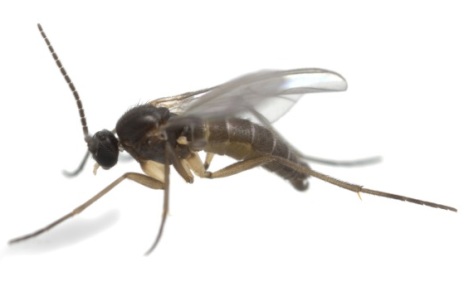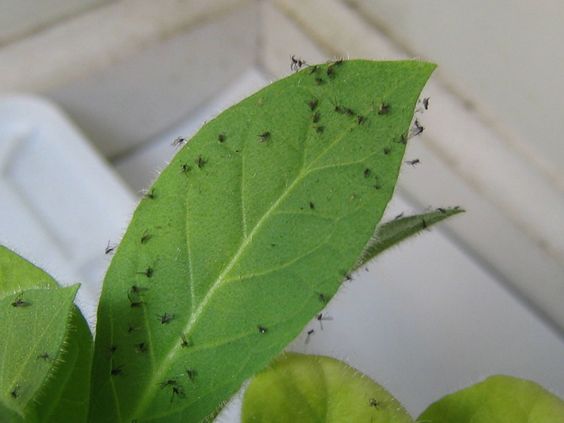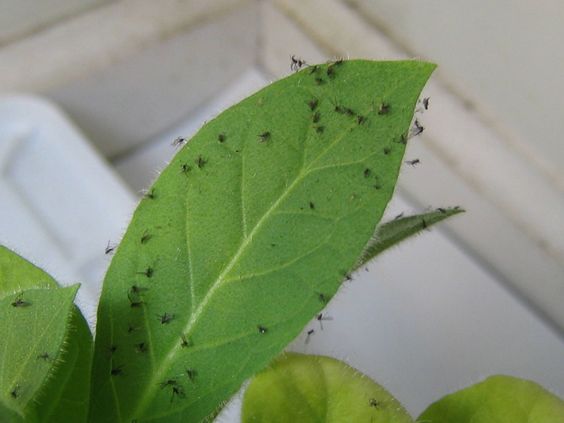Brought to you by ARBICO Organics

These itty bitty insects are fungus gnats, although they go by many names, including “soil maggots”, “soil gnats”, and, (very commonly) “fruit flies”. People often mistake fungus gnats for fruit flies, but if you look closely you will see that they look more like tiny mosquitoes than any kind of fly. Although they look like mosquitoes, they don’t behave like them. They can’t bite and are utterly harmless to humans. However, they do have a nasty habit of flying around people’s faces, so it’s pretty easy to inhale or swallow one. It’s an unpleasant experience but not necessarily dangerous.
Many people say that fungus gnats are worse in winter, but they may have been around all year long and you just didn’t notice them.Conditions in the home during winter are perfect for fungus gnats to thrive and people are inside more with their plants, so if you have a problem you will notice it during the cold weather months.

Fungus gnat adults are harmless to plants – it is their offspring that cause the trouble. The adults lay their eggs in soil and within 3 days the larvae emerge and they are mighty hungry. Their foods of choice are fungi, decaying organic matter, and plant roots and they begin feeding as soon as they hatch. This feeding continues for about 10 days, at which time the larvae will pupate. A short 4 days later, the adults emerge from the pupae ready to reproduce. This short life cycle means that you could potentially have a continuous population of fungus gnats in your plants. When you take into consideration that these insects will thrive all year round in your climate-controlled home, it pays to be on guard and prepared to put down any potential infestations.

Because the larvae do their feasting underground, the signs of their activity are often hidden until the damage has been done and the plants are visibly suffering. Your best tactic is to be pro-active and take the following steps:Watch for flying adults – Fungus gnats are not great fliers, so you won’t see swarming like other insects do. What you may see is their sudden appearance as you water or turn lights on. The water will disrupt their hop-flying around the soil and, like other insects; light will draw them to it. Bear in mind that fungus gnats are very small, only 1/8”-1/10” long, and have clear wings and long antenna. If the insects flying around your plants don’t have these characteristics, then you have another insect pest problem.
Watch your watering – Proper watering is not only important for overall plant health, it is an invaluable tool to control soil-dwelling larvae. Simply put, fungus gnats like living in soggy potting soil. Remember that plants require less water in winter, so your regular watering schedule should be cut back in cold months. Make sure that your plants are draining thoroughly and give the top couple of inches of soil (where the larvae like to dwell) a chance to dry out between waterings.
If you would like more information on ways to control fungus gnats, you can go to ARBICO Organics fungus gnats page. Interestingly, although these gnats are not related to mosquitoes, many of the products used to control mosquitoes work for them as well.
Pam Couture is the Lead Content Writer at ARBICO Organics. She lives in Tucson, Arizona, where she is surrounded by family, friends and nature. ARBICO Organics can be contacted at 800.827.2847 and you can visit their website at ARBICO-Organics.com.
Related Articles & Free Email Newsletter
Growing Healthy, Productive and Profitable Plants through Succession Planting
Natural Mite and Pest Control Options for Your Orchids



Comment here